on sharing, yachting, fueling, winning, & erping
Subscribe to a car then share it. . .Bentley’s sumptuous yacht interior. . . lithium, oil and hydrogen. . .from full-size to 1:64. . .Toyota’s new Crowns. . .ranking countries by green-cred. . . clever speaker design. . .another amazing Accord. . .Mazda helps you on your holiday drives. . .
Sharing Is Earning

Subscribe to the Lynk & Co 01, then use it to generate some additional income. (Image: Lynk & Co)
Lynk & Co is a Geely-owned company that produces cars. Oddly enough, it is apparently more interested in providing subscriptions to its vehicles than in selling them, particularly in Europe.
What’s more, it is promoting that those who have its model 01 to share them—for income.
Alain Visser, CEO of Lynk & Co:
“Car sharing isn't just a service—it’s about enabling mobility and committing to sustainability. It's our way of revolutionizing the very essence of car ownership, paving the way for a more sustainable and inclusive tomorrow, one ride at a time.”
There have been a reasonable number of singular rides in Lynks:
The company reports that over the past 12 months subscribers who are sharing their 01s have earned €850,000. Which can be then used to pay for their subscription fees.
Lenders set their own prices. In Sweden they’ve found the average price is €9 per hour. In Italy €30.
The Netherlands leads in Lynk & Co car sharing: 22% of the 01 owners there are lending.
A Change in Mobility Models?
Which leads to a comment made by says Dr. Stefan Penthin, Global Leader Automotive and Industrial Manufacturing at Amsterdam-based consultancy BearingPoint, which recently released a paper titled:
“What happens to your business when users prioritize the consumption of mobility services over ownership?”
Penthin said:
“All industries must adjust to the mobility ecosystem of 2030. They must look at their current business model now to ensure they are fit for purpose in a future driven by services rather than hardware alone. This will mean all players will have to reorganize to face the future, focusing on the customer, whether it is B2B or B2C, ensuring they are sustainable and embrace an ecosystem that incorporates data and forecasting.”
Lynk & Co may be ahead of the game.
///
Bentley and A Lot of Yacht

Contest 67CS—yes, there is an automotive connection. (Images: Bentley)
In a review of the Contest 67CS, a 21-m sailing yacht, that appeared in Yachting News in 2020, author Luc D’Ambrosio described it as “the perfect example of how all sailboats should be built.”
And he noted (remember, this goes back a few years), “The base price of the Contest 67CS is equal to 2.6 million euros which, considering construction, equipment and finishes, is not so high.”
(Just to put that €2.6 million in 2020 into context: that would be some €3.2 million in today’s euros. Guess that’s the price of “perfect.” But it seems more than “not so high.”)
Now, as you may be wondering what an expensive yacht has to do with the auto industry, know that a particular version of the Contest 67CS that was recently commissioned probably has an even higher sticker price (or whatever the nautical analogy of the Monroney is called) than the reviewed boat:
It has a bespoke interior crafted by the design team from Bentley Motors.
“Yacht interiors, like that of a car must be exact with precision detail. Whilst it was a challenge for our design teams to adapt their craft skills to an interior, providing a totally bespoke extension to our automotive interiors for the water we are delighted with the result. The finished article is a testament to the incredible talent and skill of our craftsmen and women who rose to the challenge and pushed the boundaries of what is possible.”-- Dr Matthias Rabe, Member of the Board for Engineering at Bentley Motors
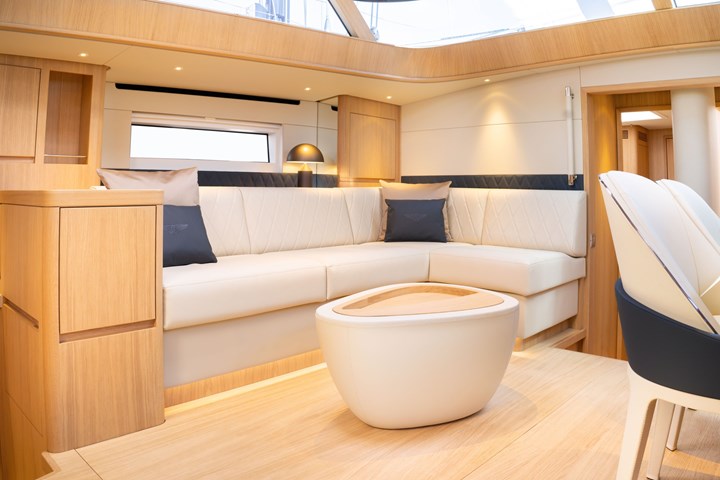
Contest 67CS below deck. How the other half sails.
Even the tissue box and drink coasters for the yacht were specifically crafted for the application.
Guess that’s what being “bespoke” is all about.
///
From Cars to What Powers Them
That ExxonMobil announced last week that it will start drilling in Arkansas—drilling for lithium, not oil—wasn’t entirely surprising.
Even though the number of EVs in the U.S. still remains comparatively low—exceedingly low if you take Tesla out of the calculation—there is undoubtedly incremental upside for ExxonMobil’s fortunes.
And there is, of course, that Inflation Reduction Act money that makes battery production exceedingly appealing for both battery companies and OEMs.
“Lithium is essential to the energy transition, and ExxonMobil has a leading role to play in paving the way of electrification,” is a statement from a company exec.
Clearly the company is, as they say, covering its bets as in October ExxonMobil invested approximately $60-billion in the acquisition of Pioneer Natural Resources, which owns more than 850,000 acres in the Permian Basin. This gives ExxonMobil a potential of 16-billion barrels of “oil equivalent resource” and provides the ability to double its production volume to 1.3 million barrels of oil equivalent per day (MOEBD), going to 2 MOEBD in 2027.
2027 is the year it plans to start producing lithium.
(How will it do it? By using the oil and gas drilling methods it is familiar with to go down about 10,000 feet to access lithium-rich salt water. They’ll bring the salt water up, use direct lithium extraction technology to separate out the lithium, then, onsite, convert the lithium to battery-grade material. The salt water will be re-injected in the ground.)
Back to the “Lithium is essential” quote.
It was made by the president of ExxonMobil Low Carbon Solutions, Dan Ammann.
You may recognize that name.
Ammann* was previously CEO of Cruise, General Motors’ currently troubled autonomous driving/services company. Ammann was named CEO of Cruise until the start of 2019, having been the president of GM.
Ammann unexpectedly left Cruise in December 2021 (at least unexpectedly to the outside world).
In March 2022 ExxonMobil announced the hire.
And There’s This. . .
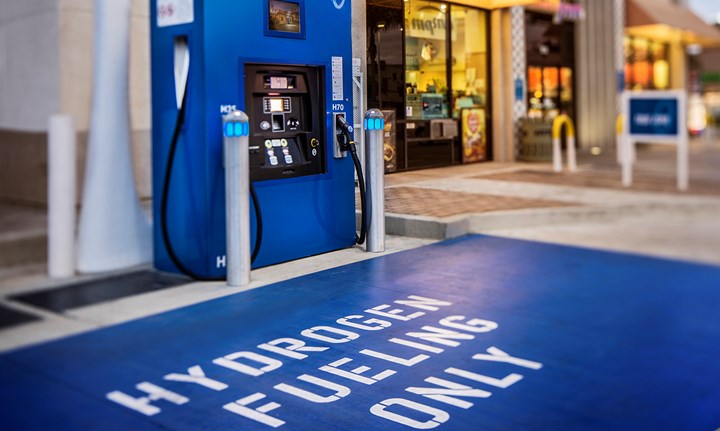
Fill up with H2. (Image: First Element Fuel)
What’s completely coincidental but interesting is how another former GM executive went from the vehicle manufacturer to a vehicle energy company.
Back in 2012 Joel Ewanick was the GM global head of marketing and quite a hot commodity.
Ewanick, an imaginative marketer, struck a $559-million, seven-year deal to put the Chevrolet logo on the uniforms of Manchester United soccer players. (See: he was way ahead of “Ted Lasso” and Ryan Reynolds and Wrexham.)
The deal ended in 2021, but Ewanick was gone weeks after the arrangement was orchestrated in 2012. The speculation was that then-GM CEO Dan Akerson had some issues with the deal. GM stopped selling cars in the UK—and other European markets—in 2015. In 2017 it sold GM Europe to PSA Peugeot-Citroën, which subsequently became Stellantis. Apparently those bowtie logos on the uniforms weren’t all that useful.
Ewanick? He went on to become a co-founder of First Element Fuel, a California-based hydrogen fuel company for vehicles. He’s presently the company’s CEO and chairman. First Element Fuel operates True Zero, a company that operates a network of hydrogen fueling stations in California. Among its partners are Toyota and Honda.
Not GM.
==
*Ammann hails from New Zealand. So he could be added to the list in the item below.
///Hot Wheels Winner
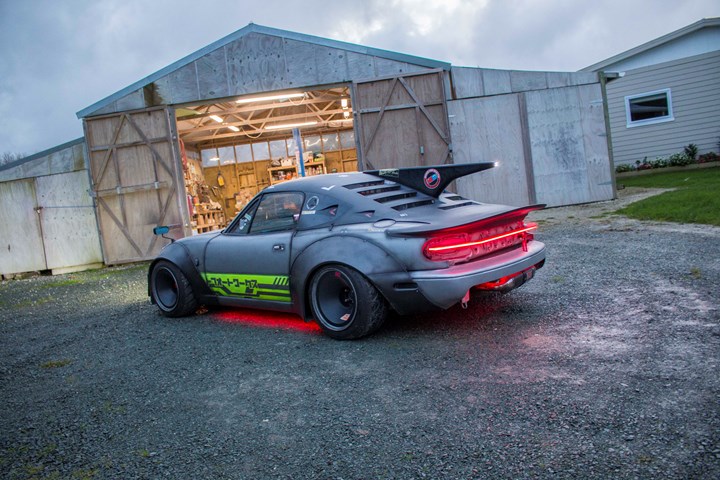
Well, maybe the future won’t look exactly like this. . . . (Image: Hot Wheels)
While unlikely to join the ranks of Peter Jackson, Lorde, Russell Crowe, and Lucy Lawless, credit to New Zealander Chris Watson who transformed a 1990 Mazda MX-5 roadster, working in a shed in northern New Zealand, into a vehicle he nicknamed “Chimera.”
The car was modified using elements of the Japanese Kaido racer style—which includes lowering the vehicle and putting on emphatic wheels: Watson deployed 15 x 13-inch turbofan wheels under 100-mm arches that he designed—and a cyberpunk aesthetic (e.g., he airbrushed the exterior so the exterior looks futuristic. . .but weathered: the future will apparently be more like Blade Runner than “Star Trek”).
Why Is This Notable?
Watson’s car was selected as the winner of the global 2023 Hot Wheels Legends Tour design competition, which encompassed 16 countries, five continents, and thousands of vehicles.
The car will become a 1:64 Hot Wheels diecast vehicle.
Among the judges were Mercedes-Benz designer Dalal Elsheikh, automotive photographer Larry Chen, and a man who probably owns as many full-size vehicles as most Hot Wheels collectors own 1:64-scale cars, Jay Leno.
A Few Fun Facts
(1) The first Hot Wheels was produced in 1968, a Camaro; (2) there are some 519 million vehicles produced every year, clearly dwarfing the 1:1 global vehicle production rate; (3) according to NPD, which tracks such things, Hot Wheels vehicles were the number-one selling toy in the world in 2022: perhaps young people really do like cars.)
///
M-B at Work with AI

Mercedes is bringing ChatGPT to its employees. (Image: Mercedes-Benz)
Mercedes-Benz has determined its employees need to know more about AI, so it has developed an internal web app for them, “Mercedes-Benz Direct Chat.”
It is based on OpenAI’s ChatGPT and is accessed through Microsoft Azure OpenAI service.
Among the things that the app will do for its employees are the creation of emails, reports and other work documents.
An assumption is that it will save time and thereby boost efficiency.
“Artificial intelligence won’t just support in taking over repetitive and routine tasks, it can also support more complex processes. This will increasingly free up time and capacity for more creative and more demanding activities.”-- Sabine Kohleisen, Member of the Board of Management of Mercedes-Benz Group AG responsible for Human Relations and Labor Director
This just isn’t a matter of putting an icon on homepage (like the one that exists on the top-right of Bing), but the company is providing training courses for all employees through its Turn2Learn qualification initiative so that they can understand what Direct Chat is and what it can do for them (and, of course, the company).
As Kohleisen described Turn2Learn when it was launched last year:
“Everyone can continue their education dependent of times and space, and across all units and levels.”
Main focus areas are digitalization and AI.
Mercedes is serious about this: It is investing €2 billion on a global basis by 2030 in getting its workforce up to date by 2030.
///
The Crown(s)
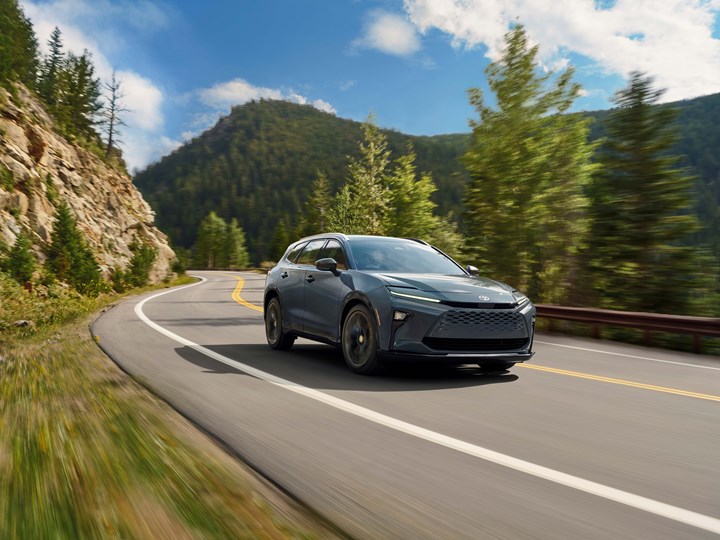
The 2025 Toyota Crown Signia hybrid crossover. (Images: Toyota)
The 2025 Toyota Crown Signia SUV had its North American debut last week, making it the second Crown model in the Toyota lineup, with the Toyota Crown sedan becoming available earlier this year.
Both models are available only with hybrid powertrains. When it becomes available in summer 2024, the Crown Signia will be the 19th electrified model in the Toyota lineup.*
(The Signia features a 2.5-liter DOHC four-cylinder engine with two electric motor generators providing 243 hp; it has a manufacturer-estimated rating of 36 mpg combined.)
While the Crown nameplate was absent from the U.S. market for 51 years, Toyota has been selling Crowns in Japan (and elsewhere) since 1955.
Over In Japan. . .
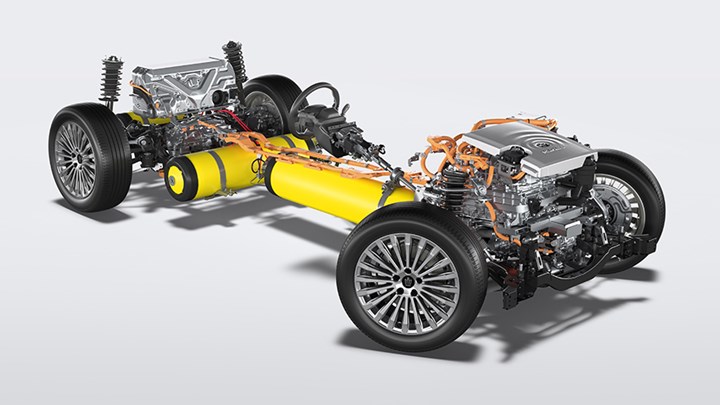
In Japan, there’s a Crown with a fuel cell-based propulsion system.
Which brings us to another Crown introduced in Toyota City earlier this month, its “flagship” Crown sedan powered by a fuel cell.
The fuel cell electric vehicle (FCEV) Crown features three high-pressure hydrogen tanks that provide a range of approximately 510 miles. And they’re filled from a pump in about three minutes.
The second-generation solid polymer electrolyte fuel cell system used for the Crown is also available in the Mirai, which is available in the U.S.—well, at least you can get a Mirai in California.
Toyota also introduced a new Crown hybrid sedan in Japan that’s powered by an all-new 2.5-liter multistage hybrid system.
It is interesting to note that last year Toyota announced four new Crowns for the Japan market—it started with the SUV.
*Speaking of Toyota and hybrids, last week it also announced the 2025 Camry—the ninth generation of the sedan that has been the best-selling car in the U.S. for 21 years running. It will be available as a hybrid. Period. There will be a FWD version with a net horsepower (from a 2.5-liter four cylinder engine and its electric motors) of 225; the AWD variant produces 232 hp. For the AWD setup it is noted that the electronic all-wheel drive system used produces 30 more hp than the current Camry hybrid with a mechanical AWD arrangement.
///
How Green Is the U.S.?
People in the U.S. like to think that at the very least they are environmentally aware to a superb degree.
After all, the world’s first Earth Day was held in the U.S. back in 1970.
But it seems as though America may not be so green, at least according to British firm DriveElectric, which analyzed an array of research, ranging from bp’s Statistical Review of World Energy to the OECD’s Environmental Policy Stringency (EPS) Index.
In fact, the U.S., compared to other countries, is light green at its darkest when it comes to things including percentage of renewable energy consumption to percentage of emissions reduction.
Specifically:
- Greenest Country in the World. This is based on target percentage of emissions reduction by 2030; EPS index; percentage of total energy consumption from renewables; percentage of total energy consumption from solar; YoY difference in electric vehicle sales; railway usage; percentage of total energy consumption from hydro; percentage of energy consumption from nuclear. The U.S. doesn’t make the top 10. Surprisingly, China is at 9. This is largely predicated on its targeted emissions reduction by 2030, YoY difference in EV sales, and railway usage.
- Countries with the Highest Level of Nuclear Energy Consumption. The U.S. isn’t in the top 10. France is #1.
- Countries that Use the Most Renewable Energy. U.S. doesn’t make it. (Denmark is #1 with 40.3%. Finland is #2—back at 21.6%.)
- Countries with the Highest Solar Power Consumption. While it isn’t surprising that Australia is #1, it is surprising that while Hungary (2), Netherlands (4), and Japan (8) are on the top-10 list (let’s face it: these aren’t exactly places you go to to get a tan), the U.S. isn’t. And we have Hawaii.
- Countries with the Highest Hydroelectricity Consumption. Nope. Norway is #1.
- Countries with the Highest Railway Usage. Not one of the 10. China is #1.
But it isn’t a complete wash:
- Countries with the Highest Increase in EV Sales. “We’re number 10! We’re number 10!. . .” Yes, the U.S. makes it on this list. Behind:India, Brazil, New Zealand, Japan, Israel, Turkey, South Africa, Poland, and Australia.
Well, there is a lot of upside opportunity.
///
Removing Rare Earths

Put them together and get a car audio speaker. Without rare earths. (Image: Warwick Acoustics)
“More and more inquiries are coming in from OEMs wishing to eliminate sources of REE from their vehicles due to the toxic waste generated in the mine-to-magnet process and supply chain stability. The big target has been permanent magnets in electric motors, with each motor containing roughly 500 g of REEs.”
That’s Mike Grant, CEO of British audio technology firm Warwick Acoustics.
REE? Rare earth elements.
So why is he talking about REEs in electric vehicle motors when his company is in the audio business?
Because he also says this:
“As much as 30% of the total REE content in a premium EV is actually in the audio system.”
More specifically, in the magnets used in the moving-coil speakers.
Warwick Acoustic has developed what it calls “ElectroAcoustic panels” that eliminate the need for magnets in a loudspeaker because it uses an electrostatic transducer that vibrates air via a 15 µm membrane that is centered between two electrically conductive stators. Those vibrations lead to acoustic output, a.k.a., sound.
No magnets needed.
The loudspeaker is said to be 90% lighter than a traditional device.
What’s more, the company’s chief technology officer, Ben Lisle, says:
“Our technology doesn't just eliminate REE content. We also use ‘100% by mass’ upcycled and easily recyclable materials in the manufacturing process to produce a final product that is highly sustainable, and, given its very simple design, easy to disassemble at end of life.”
Speakers that are light, sustainable and thin. Sounds interesting. No pun intended.
///
2024 Honda Accord Hybrid Touring
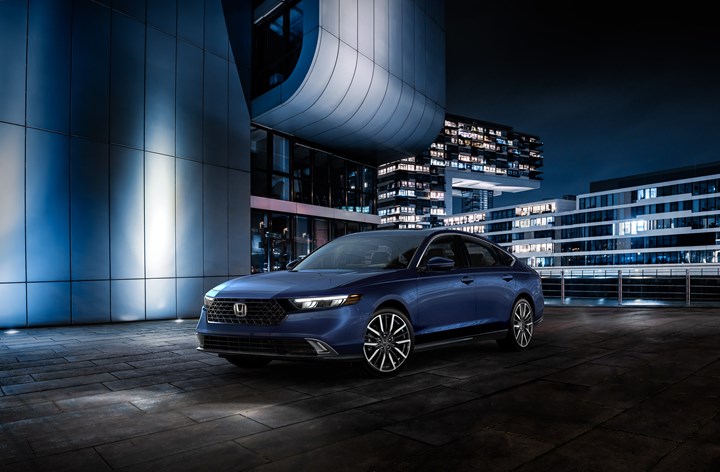
Eleventh-generation Honda Accord. Year after year, better and better. (Image: Honda)
If we were to turn back the clock a few decades and looked at the roads, we’d see things were significantly different. People were generally driving cars. Some had four doors. Some had two. Some were convertibles. Some had giant engines. Some were small and propulsionately anemic.
But they were cars.
Then some product planners in Detroit came to a recognition that the few vehicles on the roads back then, now widely known as “SUVs,” were transacting at much higher sticker prices than cars were. Those SUVs were typically based on pickup truck chassis and had additional square inches of sheet metal and glass, but all the other elements that were being put into cars (steering wheel, seats, engine, transmission, etc.) were being used, yet the prices paid for the vehicles were more than proportionately higher.
Of course, some of these SUVs came with the ability to drive on terrain that had previously been pretty much ceded to drivers of Jeeps, and Jeeps back then were far from being as comfortable as they are now (yes, today’s Wranglers are comparatively luxe).
And then there were the pickup trucks from those days. They were generally Spartan compared with cars. Consequently, they were less expensive. Turned out that many people who would never need the utility of an open box on the back of their vehicle (a run to the grocery store was readily accommodated by a trunk) were buying trucks for their daily commute thanks to the afforability.
So some product planners in Detroit decided that if they made trucks nicer inside—replacing the vinyl and plastics that resembled sheet metal—they could, as was the case with SUVs, charge more for them.
The operative sense of thinking was “Trucks and SUVs provide better margins than cars.”
So the efforts of the Traditional Three focused on SUVs and trucks. Cars became something of an afterthought. . .at most.
Ford? There’s the Mustang. Chevy? Do you think the Malibu gets a whole lot of attention nowadays when every other announcement out of GM seems to be about EVs and SUVs? Chrysler? No cars are available from that brand, so you have to go to the Dodge side of the dealership for the Charger and Challenger.
Meanwhile, Honda has been producing the Accord in its factory in Marysville, Ohio, since 1982. It is now building the 11th generation, which was introduced earlier this year.
And year in, year out, the Accord has been getting better. Part of this improvement, no doubt, was inspired by the competition (mainly things like the Camry and Sonata), with all of them upping their game in sedan styling and amenities.
Style & Size
While probably not something cross-shopped with the Accord, arguably the styling of this 11th gen was predicated on more than a glance at higher-priced German vehicles. (Yes, the Germans still build cars, too.) It has levels of sophisticated sportiness that the model has not carried before.
Seeing it for the first time evokes a “That’s an Accord?!?”
And I suspect that for those who have one in their driveway the stance and sheet metal styling provoke a smile even long after the new-car smell has gone away.
In the case here, it is the Touring model, which means that it has a long list of interior amenities, but what’s more to the point is that there is the classic Honda attention to ergonomic detail such that the things inside are place or engineered for optimal use: even the vent controls are designed for ease of use. When you’re living with something for several years, those little things take on a major importance.
While this is a good-sized midsize sedan (length: 195.7 inches; width: 73.3 inches; height: 57.1 inches; wheelbase: 111.4 inches; passenger volume: 102.8 cubic feet; cargo volume: 16.7 cubic feet), the hybrid powertrain provides impressive fuel-efficiency numbers.
The EPA puts it at 46 mpg city, 41 mpg highway and 44 mpg combined.
The propulsion system is based on the fourth generation of the Honda two-motor hybrid system. There are a 2.0-liter Atkinson-cycle four-cylinder engine and an electric power unit that combines two electric motors. It produces 204 hp. The car moves well on neighborhood streets as well as interstates. The hybrid is absolutely transparent to the driver.
It's good to still have cars. Especially really good ones like the Accord.
///
Erp!
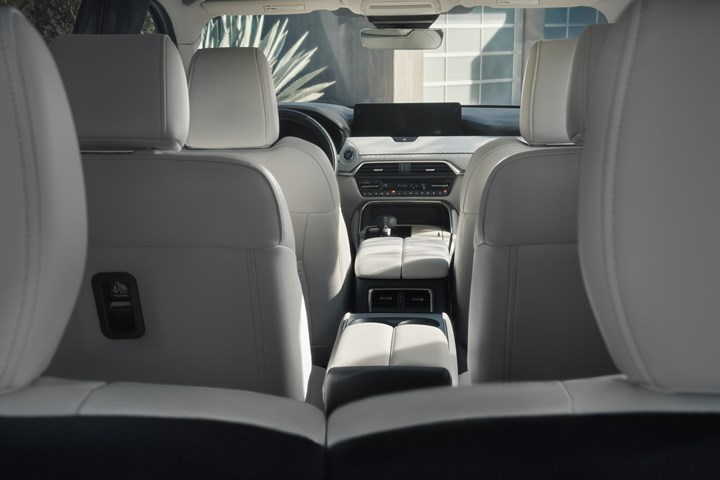
The interior of the Mazda CX90 is not the sort of place where you want to have to deal with the consequences of. . .car sickness. It is just too nice. (Image: Mazda)
As Thanksgiving Day in the U.S. is this week. . .
With the holidays come more road trips. Eighty-five percent of parents or caregivers plan to hit the road this holiday season—and 93% of those who have three or more children to transport.
A concern that 61% surveyed have?
That one of the kids will get carsick.
And this isn’t a theoretical concern.
For 48% of those surveyed, an erping child is something they’ve had to deal with at some point.
Mazda North American Operations, which sponsored the survey taken last month that provides those data points, partnered with pediatrician Dr. Mona Amin to get her suggestions for dealing with carsickness, which she says is caused because “your brain receives conflicting information from the nerves—essentially your body cannot infer whether it is in motion or not.”
Her recommendations:
- Increase airflow. Keep the air flowing in and the temperature in the vehicle down.
- Look straight ahead. This is said to address some of the sensory conflicts.
- Avoid reading or looking at screens. Doing either of those things can create confusion between visual cues and the inner ear’s sense of movement. An audiobook or music are alternatives.
(Mazda sponsored the survey in relation to its new CX-90 SUV, which has three rows and can accommodate eight—an ideal road-tripping vehicle. It has a really nice interior, something you wouldn’t want to have erp in.)
\\\
RELATED CONTENT
-
On Fuel Cells, Battery Enclosures, and Lucid Air
A skateboard for fuel cells, building a better battery enclosure, what ADAS does, a big engine for boats, the curious case of lean production, what drivers think, and why Lucid is remarkable
-
Jeeps Modified for Moab
On Easter morning in Moab, Utah, when the population of that exceedingly-hard-to-get-to town in one of the most beautiful settings on Earth has more than doubled, some people won’t be hunting for Easter eggs, but will be trying to get a good look at one of the vehicles six that Jeep has prepared for real-life, fast-feedback from the assembled at the annual Easter Jeep Safari.
-
Things to Know About Cam Grinding
By James Gaffney, Product Engineer, Precision Grinding and Patrick D. Redington, Manager, Precision Grinding Business Unit, Norton Company (Worcester, MA)


.jpg;width=70;height=70;mode=crop)






